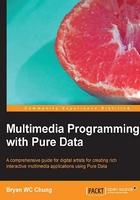
上QQ阅读APP看书,第一时间看更新
Understanding the terms and interface
There are a number of terms we need to clarify before we proceed.
- Operation modes: Pure Data works in two modes: Edit Mode and Run Mode. In Edit Mode, you can create and modify your program source in the patch window. In Run Mode, you execute the patch and modify data. Nevertheless, the patch will not stop playing when you switch between Edit and Run mode. You switch between the two modes by navigating to Edit | Edit mode. In Edit Mode, the cursor is a finger. In Run Mode, the cursor is the normal pointer. You can also use the keyboard shortcuts Command + E for Mac and Ctrl + E for Windows.
- Programming elements: All programming elements in Pure Data are either object or data. Objects are functional elements that mainly perform tasks. Data will be the material that objects operate with. For example, a Pure Data object
printwill display text messages on screen whereas thedatummessage will be the text to be displayed. Programming in Pure Data involves putting objects and data in the patch window—canvas, and connecting them together. - Input/output: Programming in Pure Data involves connecting the output from one item to the input of another item. Nevertheless, Pure Data uses the terms inlet and outlet, instead of input and output. We'll see an example in the next section.
- Windows: Each Pd patch comes with its canvas window. The other window with a lot of messages is the console window. You may need to pay attention to the console window, as it will show you the error messages in case you come into problem. To clear messages in the console window, choose Edit | Clear console. The keyboard shortcut is Shift + Command + L in Mac, Shift + Ctrl + L for Windows.